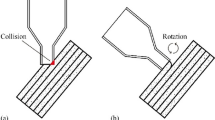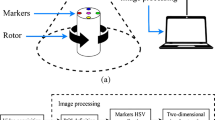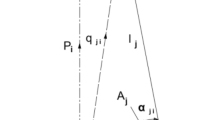Abstract
In this paper, a general error identification and compensation method is proposed for the position-independent geometric errors (PIGEs) of dual rotation axes of cradle-type five-axis machine tools with non-intersecting rotation axes. A unique hole machining specimen is designed to evaluate the compensation effect. First, the kinematic error model of the five-axis machine tool is established based on the dual quaternion, and the correlation between the PIGEs defined based on the dual quaternion and the PIGEs in ISO 230–7 is analyzed. Then, eight PIGEs of the two rotation axes are simultaneously identified by using a double-ball bar (DBB) through the synchronous motion trajectory of the A- and C-axes. Moreover, an error compensation strategy based on the principle of tool pose approximation is proposed, which preferentially compensates for the direction error. The direction and position vector errors of the tool are directly compensated by establishing the ideal and actual relative pose difference model between the tool and workpiece. Finally, a unique hole machining experiment on a circular cone surface is proposed according to the position structure of the rotation axis of the target machine tool. The machining of the hole on the conical surface is realized by controlling the tool through the motion of the rotation axis, thus effectively avoiding the influence of the translational axis. The effectiveness of the proposed compensation strategy is verified by the measurement and fitting of the points on the machining hole wall by a three-coordinate measuring machine. The average residual error after compensation is reduced by about 88.65% and 85.2% compared with that before compensation by using the established position error and direction error compensation evaluation function.













Similar content being viewed by others
Data availability
All data generated or analyzed during this paper are included in this published article.
Code availability
Not applicable.
References
Lee KI, Yang SH (2013) Measurement and verification of position-independent geometric errors of a five-axis machine tool using a double ball-bar. Int J Mach Tools Manuf 70(7):45–52. https://doi.org/10.1016/j.ijmachtools.2013.03.010
Lei WT, Paung IM, Yu CC (2009) Total ballbar dynamic tests for five-axis CNC machine tools. Int J Mach Tools Manuf 49(6):488–499. https://doi.org/10.1016/j.ijmachtools.2009.01.003
Ramesh R, Mannan MA, Poo AN (2000) Error compensation in machine tools - a review: part I: geometric, cutting-force induced and fixture-dependent errors. Int J Mach Tools Manuf 40(9):1235–1256. https://doi.org/10.1016/S0890-6955(00)00009-2
Wu HR, Zheng HL, Li XX, Wang WK, Xiang XP, Meng XP (2020) A geometric accuracy analysis and tolerance robust design approach for a vertical machining center based on the reliability theory. Measurement 161:107809. https://doi.org/10.1016/j.measurement.2020.107809
Jiang XG, Cripps RJ (2015) A method of testing position independent geometric errors in rotary axes of a five-axis machine tool using a double ball bar. Int J Mach Tools Manuf 89:151–158. https://doi.org/10.1016/j.ijmachtools.2014.10.010
ISO 230–7 (2015) Test code for machine tools-part 7: geometric accuracy of axes of rotation. ISO
Xiang ST, Altintas Y (2016) Modeling and compensation of volumetric errors for five-axis machine tools. Int J Mach Tools Manuf 101:65–78. https://doi.org/10.1016/j.ijmachtools.2015.11.006
Fan JW, Tao HH, Pan R, Chen DJ (2020) An approach for accuracy enhancement of five-axis machine tools based on quantitative interval sensitivity analysis. Mech Mach Theory 148:103806. https://doi.org/10.1016/j.mechmachtheory.2020.103806
Zhong GY, Wang CQ, Yang SF, Zheng EL, Ge YY (2015) Position geometric error modeling, identification and compensation for large 5-axis machining center prototype. Int J Mach Tools Manuf 89:142–150. https://doi.org/10.1016/j.ijmachtools.2014.10.009
Yang JX, Mayer JRR, Altintas Y (2015) A position independent geometric errors identification and correction method for five-axis serial machines based on screw theory. Int J Mach Tool Manuf 95:52–66. https://doi.org/10.1016/j.ijmachtools.2015.04.011
Xi XC, Liu HD, Chen H, Ye L, Zhao WS (2019) Kinematics for a six-axis EDM machine by screw theory and its application in feedrate planning in EDM for shrouded blisks. Int J Adv Manuf Technol 105(3):1–11. https://doi.org/10.1007/s00170-019-04311-y
Qiao Y, Chen YP, Yang JX, Chen B (2017) A five-axis geometric errors calibration model based on the common perpendicular line (CPL) transformation using the product of exponentials (POE) formula. Int J Mach Tools Manuf 118–119:49–60. https://doi.org/10.1016/j.ijmachtools.2017.04.003
Liu Y, Wan M, Xiao QB, Zhang WH (2019) Identification and compensation of geometric errors of rotary axes in five-axis machine tools through constructing equivalent rotary axis (ERA). Int J Mech Sci 152:211–227. https://doi.org/10.1016/j.ijmecsci.2018.12.050
Li J (2018) Relative position and attitude coordinated control based on unit dual quaternion. Adv Mech Eng 10(12):1–9. https://doi.org/10.1177/1687814018818971
Gao W, Ibaraki S, Donmez MA, Kono D, Mayer JRR, Chen YL, Szipka K, Archenti A, Linares JM, Suzuki N (2023) Machine tool calibration: measurement, modeling, and compensation of machine tool errors. Int J Mach Tools Manuf 287:104017. https://doi.org/10.1016/j.ijmachtools.2023.104017
Schwenke H, Knapp W, Haitjema H, Weckenmann A, Schmitt R, Delbressine F (2008) Geometric error measurement and compensation of machines—an update. CIRP Ann Manuf Technol 57(2):660–675. https://doi.org/10.1016/j.cirp.2008.09.008
Budzyn G, Rzepka J, Kaluza P (2021) Laser interferometer based instrument for 3D dynamic measurements of CNC machines geometry. Opt Laser Eng 142(4). https://doi.org/10.1016/j.optlaseng.2021.106594
Ding M, Li HM, Xiang ST, Liu PL, Feng XB, Du ZC, Yang JG (2020) Geometric errors identification considering rigid-body motion constraint for rotary axis of multi-axis machine tool using a tracking interferometer. Int J Mach Tools Manuf 158:203625. https://doi.org/10.1016/j.ijmachtools.2020.103625
Wang JD, Guo JJ (2019) The identification method of the relative position relationship between the rotary and linear axis of multi-axis numerical control machine tool by laser tracker. Measurement 132:369–376. https://doi.org/10.1016/j.measurement.2018.09.062
Ibaraki S, Oyama C, Otsubo H (2011) Construction of an error map of rotary axes on a five-axis machining center by static R-test. Int J Mach Tools Manuf 51:190–200. https://doi.org/10.1016/j.ijmachtools.2010.11.011
Woniak A, Mczyńska K (2020) Measurement hysteresis of touch-trigger probes for CNC machine tools. Measurement 156:107568. https://doi.org/10.1016/j.measurement.2020.107568
Tsutsumi M, Tone S, Kato N, Sato R (2013) Enhancement of geometric accuracy of five-axis machining centers based on identification and compensation of geometric deviations. Int J Mach Tools Manuf 68:11–20. https://doi.org/10.1016/j.ijmachtools.2012.12.008
Lee KI, Yang SH (2013) Robust measurement method and uncertainty analysis for position-independent geometric errors of a rotary axis using a double ball-bar. Int J Precis Eng Man 13(2):231–239. https://doi.org/10.1007/s12541-013-0032-z
Xiang ST, Yang JG, Zhang Y (2014) Using a double ball bar to identify position independent geometric errors on the rotary axes of five-axis machine tools. Int J Adv Manuf Technol 70(9–12):2071–2082. https://doi.org/10.1007/s00170-013-5432-9
Matsuzaki K, Takatsuji T, Ssto O (2023) Evaluation and compensation of geometrical errors of X-ray computed tomography system using a laser tracking interferometer. Precis Eng 80:243–255. https://doi.org/10.1016/j.precisioneng.2023.01.002
Bi QZ, Huang ND, Sun C, Wang YH, Zhu LM, Ding H (2015) Identification and compensation of geometric errors of rotary axes on five-axis machine by on-machine measurement. Int J Mach Tools Manuf 89:182–191. https://doi.org/10.1016/j.ijmachtools.2014.11.008
Zhou XD, Jiang ZX, Song B, Tang XQ, Zheng SQ (2017) A compensation method for the geometric errors of five-axis machine tools based on the topology relation between axes. Int J Adv Manuf Technol 88(5–8):1993–2007. https://doi.org/10.1007/s00170-016-8919-3
Peng FY, Ma JY, Wang W, Duan XY, Sun pp. Yan R, (2013) Total differential methods based universal post processing algorithm considering geometric error for multi-axis NC machine tool. Int J Mach Tools Manuf 70:53–62. https://doi.org/10.1016/j.ijmachtools.2013.02.001
Wang H, Jiang XG (2023) Identification and compensation of position independent geometric errors of dual rotary axes for hybrid-type five-axis machine tool based on unit dual quaternions. Measurement 211:112587. https://doi.org/10.1016/j.measurement.2023.112587
Hsu YY, Wang SS (2007) A new compensation method for geometry errors of five-axis machine tools. Int J Mach Tools Manuf 47(2):352–360. https://doi.org/10.1016/j.ijmachtools.2006.03.008
Wang H, Jiang XG (2022) Geometric error identification of five-axis machine tools using dual quaternion. Int J Mech Sci 299:107522. https://doi.org/10.1016/j.ijmecsci.2022.107522
Qin YD, Geng PX, Lv BW, Meng YY, Song ZC, Han JD (2022) Simultaneous calibration of the hand-eye, flangetool and robot-robot relationship in dual-robot collaboration systems. Sensors 22(5). https://doi.org/10.3390/s22051861
Dantam NT (2020) Robust and efficient forward, differential, and inverse kinematics using dual quaternions. Int J Robot Res 4:1–19. https://doi.org/10.1177/0278364920931948
Yang JX, Altintas Y (2013) Generalized kinematics of five-axis serial machines with nonsingular tool path generation. Int J Mach Tools Manuf 75:119–132. https://doi.org/10.1016/j.ijmachtools.2013.09.002
Kavan L, Collins S, Žára J, O’Sullivan C (2008) Geometric skinning with approximate dual quaternion blending. ACM Trans Graph 27(4):1–23. https://doi.org/10.1145/1409625.1409627
Funding
The work received financial support sponsored by the National Natural Science Foundation of China (51905377) and the Tianjin Natural Science Foundation (20JCQNJC00040). Thanks also goes to Mr. Wenguo Qi for his assistance in machine tool operation and test equipment calibration.
Author information
Authors and Affiliations
Contributions
HW: writing (original draft preparation), methodology, software, investigation, experiment, data curation, and visualization; XJ: supervision, conceptualization, resources, writing (review and editing), project administration, and funding acquisition; ML: supervision and writing (review and editing).
Corresponding authors
Ethics declarations
Ethical approval
Not applicable.
Consent to participate
Not applicable.
Consent for publication
Not applicable.
Competing interests
The authors declare no competing interests.
Additional information
Publisher's Note
Springer Nature remains neutral with regard to jurisdictional claims in published maps and institutional affiliations.
Highlights
• The correlation and difference between PIGEs defined based on dual quaternion, and those defined in ISO are analyzed.
• The effect of individual errors on the radial error of the DBB is simulated based on the error model.
• A compensation strategy based on the tool pose approximation principle is proposed.
• A special circular cone surface machining compensation specimen was designed.
Rights and permissions
Springer Nature or its licensor (e.g. a society or other partner) holds exclusive rights to this article under a publishing agreement with the author(s) or other rightsholder(s); author self-archiving of the accepted manuscript version of this article is solely governed by the terms of such publishing agreement and applicable law.
About this article
Cite this article
Wang, H., Jiang, X. & Li, M. Identification and compensation machining evaluation of position-independent geometric error of dual rotation axes. Int J Adv Manuf Technol 129, 2783–2799 (2023). https://doi.org/10.1007/s00170-023-12443-5
Received:
Accepted:
Published:
Issue Date:
DOI: https://doi.org/10.1007/s00170-023-12443-5




